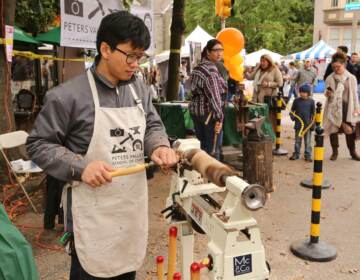Mela celebrates South Asian narratives at Princeton University Art Museum
The storytelling techniques of earlier traditions are re-imagined to fit the world of today in a new exhibit of contemporary South Asian art at Princeton University Art Museum, on view through January 15. Contemporary Stories: Revisiting South Asian Narratives presents the work of five renowned artists—Chitra Ganesh, Nalini Malani, Nilima Sheikh, Gulam Mohammed Sheikh and Shahzia Sikander—who work in
printmaking, painting and video. Concurrently, Epic Tales from India: Paintings from the San Diego Museum of Art Contemporary Stories is on view across the hall, providing historical context and comparison.
To celebrate, there will be a South Asian Arts and Music Festival at the art museum on Saturday, December 3, from 11 a.m. to 5 p.m., with storytelling, traditional cuisines and creative activities for all ages, followed by a performance by dancer Ramya Ramnarayan with live instrumental accompaniment at 10 McCosh Hall at 5:30 p.m.
The contemporary artists span two generations. Born in Gujarat in 1937, Gulam Mohammed Sheikh, the only male artist of the five (and also the spouse of Nilima Sheikh) is known for his experimental narratives, culled from diverse sources including the late medieval works of Italian artists Giotto and Duccio. He intertwines history and myth to rethink Indian and global legacies of colonialism.
His work here is a kind of a map that redraws the boundaries and combines hand painting with manipulated digital imagery. “He’s intermingling motifs,” says PUAM’s Assistant Curator of Asian Zoe Kwok, pointing out a scene from the Hindu epic Ramayana, in which Rama chases an enchanted deer, as well as St. Francis giving his sermon to the birds.
Sheikh’s wife, Nulima (born 1945), draws from mythology, folklore and personal history, addressing contemporary issues of sectarian violence as well as women’s rights. Her etching, “Majnun Bereaved,” uses mica pigment, from traditional Indian painting, that gives the work an iridescence. It is based on the doomed lovers, Layla and Majnun. “Her father declined to give Majnun Layla’s hand and so he wanders the wilderness in despair,” says Kwok, who compares the relationship to that of India and Pakistan. “When the border was drawn in 1947, there were contentious relations between the two, like lovers with a shared tradition torn apart.”
The work itself takes the form of a traditional preparatory sketch, finely detailed and devoid of color, that is itself a finished work, depicting the compassionate animals surrounding Majnun.
Both Gulam Mohammed and Nulima Sheikh have influenced the younger generation of artists.Shahzia Sikander, born in Pakistan is 1969, studied Indo-Persian miniature painting in Lahore and earned an MFA at the Rhode Island School of Design. She frees miniature painting from its role as a carrier of traditional cultural heritage, bringing historical and feminized myths into a contemporary practice. In her work, one can find gopis—female worshippers of Krishna who fall in love and blindly follow him about. “She uses it as a device to talk about women in society,” says Kwok.
Alongside a work on paper of a composite elephant, Sikander has animated the mythical, fantastical animal in a video, telling a story as the different elements add onto each other and then disappear. A traditional version of the composite elephant can be seen downstairs in the South Asian galleries.
In one especially extraordinary work, Sikander, who won a MacArthur Genius Grant in 2006, turns the Indo-Persian miniature on its head, rendering it as an oversized work on paper, more than five-feet-by-six-feet in dimension. “The Elusive Motif” reproduces the format of the muraqqa, an Indo-Persian album that is a patchwork of artistic and calligraphic elements, with a flattened perspective of mountains, borders and black line work. The swirling bird-like forms are gopis, used to show the struggles that women have to assert power. Upon closer inspection one sees they are not birds at all, but hair coifs, lifted off bodies and brought together in swirling masses.
Two site-specific works by Sikander—a 60-foot mosaic and 25-foot luminous multilayered glass painting—have been commissioned by the University and will be permanently installed at the newly renovated 20 Washington Road, the former Frick Chemistry Lab that is the new home to the Economics Department. These are Sikander’s first forays into glass.
Artist Chitra Ganesh is interested in the intersection of ancient myth and popular culture. The artist draws from Hindu, Greek, Buddhist and 19th-Century European portraiture to comics, Bollywood, anime and contemporary art. Her multimedia practice explores alternative narratives of consciousness and sexuality.
Nalini Malani was born in 1946 in Karachi in present day Pakistan, a year before the partition of India and contentious formation of Pakistan. Her family’s refugee experience informs her work as she looks at alternative histories. “In Search of Vanished Blood” takes its name from a poem by revolutionary Pakistani poet Faiz Ahmed Faiz, lamenting those most susceptible to war and injustice, and is indeed the color of blood, with demonic figures swirling about the lines of the poetry: “No one had the time to listen. No one the desire. It kept crying out.”
The art of South Asia, both past and present, is one of the world’s richest visual traditions, says PUAM Director James Steward, and in advancing past traditions, these fives artists remind us why those traditions still matter today.
________________________________________
The Artful Blogger is written by Ilene Dube and offers a look inside the art world of the greater Princeton area. Ilene Dube is an award-winning arts writer and editor, as well as an artist, curator and activist for the arts.
WHYY is your source for fact-based, in-depth journalism and information. As a nonprofit organization, we rely on financial support from readers like you. Please give today.









